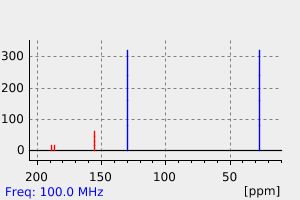2,6-二丙-2-基环己-2,5-二烯-1,4-二酮 | 1988-11-0
中文名称
2,6-二丙-2-基环己-2,5-二烯-1,4-二酮
中文别名
2,6-二异丙基-1,4-苯醌(丙泊酚杂质J)
英文名称
2,6-diisopropyl-1,4-benzoquinone
英文别名
2,6-diisopropylcyclohexa-2,5-diene-1,4-dione;2,6-diisopropylbenzoquinone;2,6-diisopropyl-p-benzoquinone;2,6-di(propan-2-yl)cyclohexa-2,5-diene-1,4-dione
CAS
1988-11-0
化学式
C12H16O2
mdl
——
分子量
192.258
InChiKey
DDXYWFGBQZICBD-UHFFFAOYSA-N
BEILSTEIN
——
EINECS
——
-
物化性质
-
计算性质
-
ADMET
-
安全信息
-
SDS
-
制备方法与用途
-
上下游信息
-
文献信息
-
表征谱图
-
同类化合物
-
相关功能分类
-
相关结构分类
物化性质
-
沸点:130-131 °C(Press: 4-5 Torr)
-
密度:1.032±0.06 g/cm3(Predicted)
-
溶解度:可溶于氯仿(少许)、乙酸乙酯(少许)、甲醇(少许)
计算性质
-
辛醇/水分配系数(LogP):2.3
-
重原子数:14
-
可旋转键数:2
-
环数:1.0
-
sp3杂化的碳原子比例:0.5
-
拓扑面积:34.1
-
氢给体数:0
-
氢受体数:2
安全信息
-
海关编码:2914690090
-
WGK Germany:3
-
包装等级:III
-
危险类别:6.1
-
危险性防范说明:P264,P270,P301+P310+P330,P405,P501
-
危险品运输编号:2810
-
危险性描述:H301
-
储存条件:2-8°C,干燥
SDS
上下游信息
-
上游原料
中文名称 英文名称 CAS号 化学式 分子量 —— 3,3',5,5'-tetraisopropyldiphenoquinone 2178-51-0 C24H32O2 352.517
反应信息
-
作为反应物:描述:2,6-二丙-2-基环己-2,5-二烯-1,4-二酮 在 盐酸 、 甲醇 、 sodium tetrahydroborate 、 lithium aluminium tetrahydride 、 tin(ll) chloride 作用下, 以 四氢呋喃 、 甲醇 、 二氯甲烷 、 异丙醚 、 水 为溶剂, 反应 12.08h, 生成 2-(hydroxymethyl)-5,7-diisopropyl-2,8-dimethylchroman-6-ol参考文献:名称:[EN] 6-HYDROXY-2,5,7,8-TETRAMETHYLCHROMAN-COMPOUNDS FOR THE TREATMENT OF CHRONIC OBSTRUCTIVE AIRWAY DISEASES
[FR] COMPOSÉS 6-HYDROXY-2,5,7,8-TETRAMÉTHYLCHROMAN- POUR LE TRAITEMENT DE MALADIES OBSTRUCTIVES CHRONIQUES DES VOIES RESPIRATOIRES摘要:本发明涉及用于治疗慢性阻塞性气道疾病,如慢性阻塞性肺病(COPD)或哮喘或支气管扩张症的化合物。本发明还涉及适用于治疗慢性阻塞性气道疾病的药物给药装置,例如包含本发明化合物的雾化器。具体地,本发明涉及用于治疗慢性阻塞性气道疾病,尤其是慢性阻塞性肺病(COPD)或哮喘或支气管扩张症的(6-羟基-2,5,7,8-四甲基色素-2-基)(哌嗪-1-基)甲酮或N,6-二羟基-2,5,7,8-四甲基色素-2-甲酰胺或其药用可接受的盐或碱。公开号:WO2015193365A1 -
作为产物:参考文献:名称:流动中苯酚的电化学氧化:对苯醌的通用且可扩展的获取摘要:报道了一种从廉价苯酚合成对苯醌的新颖且可扩展的方案。在以前的方法的进步中,氧化是在没有催化剂、介体或末端化学氧化剂的情况下进行的,有效地减少了浪费。电是一种可持续的、无试剂的氧化剂,具有出色的选择性。研究了质子添加剂对氧化的复杂影响并用于优化反应结果。流程协议的开发为连续生产提供了基础,该流程协议可在温和的环境条件下运行。此外,该方法的多功能性在 26 个示例中得到了证明,产率高达 99%。该反应的可扩展性在克级上得到证明,而产率没有腐蚀。DOI:10.1039/d2gc01296k
文献信息
-
A New Selective Method for the Homolytic Alkylation and Carboxylation of Quinones by Monoesters of Oxalic Acid作者:Fausta Coppa、Francesca Fontana、Edoardo Lazzarini、Francesco MinisciDOI:10.1246/cl.1992.1299日期:1992.7Alkyl and alkoxycarbonyl radicals were generated by oxidative decarboxylation of oxalic acid monoesters by persulfate; they were then utilized for the selective substitution of quinones.
-
[EN] ACRYLATE-FUNCTIONAL BRANCHED ORGANOSILICON COMPOUND, METHOD OF PREPARING SAME, AND COPOLYMER FORMED THEREWITH<br/>[FR] COMPOSÉ D'ORGANOSILICIUM RAMIFIÉ À FONCTION ACRYLATE, SON PROCÉDÉ DE PRÉPARATION ET COPOLYMÈRE FORMÉ AVEC CELUI-CI申请人:DOW SILICONES CORP公开号:WO2020142474A1公开(公告)日:2020-07-09A method of preparing an acrylate-functional branched organosilicon compound ("compound") is provided, and comprises reacting (A) a branched organosilicon compound and (B) an acrylate compound in the presence of (C) a catalyst, wherein component (A) has the general formula X-Si(R1)3, where X comprises a halogen-functional moiety and each R1 is selected from R and –OSi(R4)3, with the proviso that at least one R1 is –OSi(R4)3; each R4 is selected from R, –OSi(R5)3, and –[OSiR2]mOSiR3; each R5 is selected from R, –OSi(R6)3, and –[OSiR2]mOSiR3; each R6 is selected from R and –[OSiR2]mOSiR3; each R is an independently selected hydrocarbyl group; and 0≤m≤100; with the proviso that at least one of R4, R5 and R6 is –[OSiR2]mOSiR3. The compound prepared by the method, a copolymer comprising the reaction product of the compound and a second compound, a method of forming the copolymer, and a composition comprising the copolymer are each also provided.提供了一种制备丙烯酸酯官能化分支有机硅化合物(“化合物”)的方法,包括在催化剂存在下,使(A)分支有机硅化合物和(B)丙烯酸酯化合物发生反应,其中组分(A)具有一般式X-Si(R1)3,其中X包括卤素官能基,每个R1从R和–OSi(R4)3中选择,但至少一个R1为–OSi(R4)3;每个R4从R、–OSi(R5)3和–[OSiR2]mOSiR3中选择;每个R5从R、–OSi(R6)3和–[OSiR2]mOSiR3中选择;每个R6从R和–[OSiR2]mOSiR3中选择;每个R是独立选择的烃基;且0≤m≤100;但至少一个R4、R5和R6为–[OSiR2]mOSiR3。还提供了通过该方法制备的化合物,包括化合物和第二化合物的反应产物的共聚物,形成共聚物的方法,以及包含共聚物的组合物。
-
Quinone C–H Alkylations via Oxidative Radical Processes作者:Ryan Baxter、Akil Hamsath、Jordan GallowayDOI:10.1055/s-0037-1610005日期:2018.8context of selecting optimum radical precursors and initiators depending on quinone identity and functional groups present. A brief survey of radical additions to quinones is reported. Carboxylic acids, aldehydes, and unprotected amino acids are compared as alkyl radical precursors for the mono- or bis- C–H alkylation of several quinones. Two methods for radical initiation are discussed comparing inorganic作为特别主题“现代自由基方法及其在合成中的战略应用”的一部分发布 抽象的 报告了对醌中自由基的简要调查。将羧酸,醛和未保护的氨基酸作为烷基醌的前体进行了比较,以进行多个醌的单-或双-C H烷基化。讨论了两种引发自由基的方法,比较了无机过硫酸盐和Selectfluor作为化学计量的氧化剂。动力学分析表明,自由基引发速率的显着差异取决于自由基前体和氧化剂的特性。在根据醌特性和所存在的官能团选择最佳自由基前体和引发剂的背景下,讨论了有效生产烷基醌的合成策略。 报告了对醌中自由基的简要调查。将羧酸,醛和未保护的氨基酸作为烷基醌的前体进行了比较,以进行多个醌的单-或双-C H烷基化。讨论了两种引发自由基的方法,比较了无机过硫酸盐和Selectfluor作为化学计量的氧化剂。动力学分析表明,自由基引发速率的显着差异取决于自由基前体和氧化剂的特性。在根据醌特性和所存在的官能团选择最佳自由基前体和引发剂的
-
Selective activation of C H bond into C O bond of phenols in para-position via aerobic oxidation作者:Shilei Yang、Guoqiang Xu、Song Shi、Hongchuan Xin、Jin Gao、Zengjian AnDOI:10.1016/j.catcom.2019.02.017日期:2019.4An efficient method for the oxidation of phenols to 1,4-benzoquinones catalyzed by cuprous(I) chloride was achieved in a solution of acetonitrile and water using molecular dioxygen as an oxidant. Particularly, the inert phenols, such as phenol and mono-alkyl substituted phenols, were effectively oxidized to 1,4-benzoquinones via the selective activation of CH bond in para-position into CO bond under
-
The Reaction Nitrile Oxides with Alkyl- and Alkyl-halo-substituted<i>p</i>-Benzoquinones作者:Shinsaku Shiraishi、B. Shivarama Holla、Kiyoshi ImamuraDOI:10.1246/bcsj.56.3457日期:1983.11-6-methyl-p-benzoquinones gave two kinds of C=C adducts, one formed through the addition to the C=C of methyl-substituted side and the other to that of chlorine-substituted side, and the latter adducts were not isolable due to the prompt dehydrochlorination forming the fully-conjugated isoxazoloquinones and subsequent C=O addition of another nitrile N-oxide forming spirodioxazole derivatives.
表征谱图
-
氢谱1HNMR
-
质谱MS
-
碳谱13CNMR
-
红外IR
-
拉曼Raman
-
峰位数据
-
峰位匹配
-
表征信息
同类化合物
(5β,6α,8α,10α,13α)-6-羟基-15-氧代黄-9(11),16-二烯-18-油酸
(3S,3aR,8aR)-3,8a-二羟基-5-异丙基-3,8-二甲基-2,3,3a,4,5,8a-六氢-1H-天青-6-酮
(2Z)-2-(羟甲基)丁-2-烯酸乙酯
(2S,4aR,6aR,7R,9S,10aS,10bR)-甲基9-(苯甲酰氧基)-2-(呋喃-3-基)-十二烷基-6a,10b-二甲基-4,10-dioxo-1H-苯并[f]异亚甲基-7-羧酸盐
(1aR,4E,7aS,8R,10aS,10bS)-8-[((二甲基氨基)甲基]-2,3,6,7,7a,8,10a,10b-八氢-1a,5-二甲基-氧杂壬酸[9,10]环癸[1,2-b]呋喃-9(1aH)-酮
(+)顺式,反式-脱落酸-d6
龙舌兰皂苷乙酯
龙脑香醇酮
龙脑烯醛
龙脑7-O-[Β-D-呋喃芹菜糖基-(1→6)]-Β-D-吡喃葡萄糖苷
龙牙楤木皂甙VII
龙吉甙元
齿孔醇
齐墩果醛
齐墩果酸苄酯
齐墩果酸甲酯
齐墩果酸溴乙酯
齐墩果酸二甲胺基乙酯
齐墩果酸乙酯
齐墩果酸3-O-alpha-L-吡喃鼠李糖基(1-3)-beta-D-吡喃木糖基(1-3)-alpha-L-吡喃鼠李糖基(1-2)-alpha-L-阿拉伯糖吡喃糖苷
齐墩果酸 beta-D-葡萄糖酯
齐墩果酸 beta-D-吡喃葡萄糖基酯
齐墩果酸 3-乙酸酯
齐墩果酸 3-O-beta-D-葡吡喃糖基 (1→2)-alpha-L-吡喃阿拉伯糖苷
齐墩果酸
齐墩果-12-烯-3b,6b-二醇
齐墩果-12-烯-3,24-二醇
齐墩果-12-烯-3,21,23-三醇,(3b,4b,21a)-(9CI)
齐墩果-12-烯-3,21,23-三醇,(3b,4b,21a)-(9CI)
齐墩果-12-烯-3,11-二酮
齐墩果-12-烯-2α,3β,28-三醇
齐墩果-12-烯-29-酸,3,22-二羟基-11-羰基-,g-内酯,(3b,20b,22b)-
齐墩果-12-烯-28-酸,3-[(6-脱氧-4-O-b-D-吡喃木糖基-a-L-吡喃鼠李糖基)氧代]-,(3b)-(9CI)
齐墩果-12-烯-28-酸,3,7-二羰基-(9CI)
齐墩果-12-烯-28-酸,3,21,29-三羟基-,g-内酯,(3b,20b,21b)-(9CI)
鼠特灵
鼠尾草酸醌
鼠尾草酸
鼠尾草酚酮
鼠尾草苦内脂
黑蚁素
黑蔓醇酯B
黑蔓醇酯A
黑蔓酮酯D
黑海常春藤皂苷A1
黑檀醇
黑果茜草萜 B
黑五味子酸
黏黴酮
黏帚霉酸







